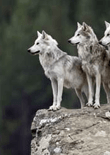Becoming the Pack Leader
By Sally Gutteridge | Behavior


In nature, puppies have a so-called “puppy license” for the first 4 or 5 months. During this time, older dogs will let them get away with all sorts of puppy behavior without retaliation. If the older dog doesn’t feel like playing with the pup, then he will often just get up and move away, or else give a quick verbal signal that he isn’t interested. Only once this “puppy license” has expired do the pups start getting real lessons in manners from the other dogs.
During her seminars, Patricia McConnell often shows two videos of Bailey, a beautiful golden retriever pup. In the first video, Bailey is perhaps 4 months old, and is chewing on a child’s stuffed toy. The woman owner tries to get the toy away from the dog by using outdated “dominance” techniques such as grabbing the puppy by the scruff of the neck and trying to make it submit to her. Retrievers are mouthy dogs and by their nature love to chew on stuff. So can anyone guess what happens after a month or two of such “training”?
In the second video, Bailey is around 6 months old. Again the dog is chewing on a toy, except that now he’s quite a bit larger. He snarls as the owner tries to get the toy away, and snaps at her hand. The owner is still faithfully following her trainer’s orders and trying to get the dog to submit to her authority. So what happens next?
Bailey was put down before he reached one year of age.
It didn’t have to happen! The dog wasn’t aggressive by nature, but simply ruined by bad training and horrible conditioning. Unfortunately, some trainers today still rely on outdated and now proven false research going back to the 1920’s, 30’s and 40’s.
In her 12-page pamphlet “How to Be the Pack Leader“, Patricia McConnell states in the introduction:
“Dogs need to feel secure to be truly happy; that means they need to feel secure that you will be the pack leader, and that they can count on you to take charge. But being the pack leader is often misunderstood. It doesn’t mean that you forcibly dominate your dog. Rather, leadership is more of a mental quality in which you set boundaries without intimidation.”
The pack leader isn’t always the strongest. Many of you have perhaps seen and wondered how a household with several dogs, sometimes the bigger dogs will acknowledge a smaller and physically weaker dog as the pack leader? Surely that alone is enough to debunk the old-fashioned myths about the biggest bully always becoming the pack leader?
So, how do we dog owners become the pack leaders? Well, it isn’t so much a matter of forcing ourselves into the position as getting our dogs to accept us as such. Sounds much tougher than just pinning a dog to the floor in an alpha roll, doesn’t it? Well, yes, it requires a bit more work, and a bit more thought, and a bit more effort.
During his presentation, Anders Hallgren put up a slide with common training advice that soon had us all nodding our heads in recognition. I’m sure you’ve heard them all, too. Perhaps you’ve even been faithfully following them as an integral part of your training routine…
These rules are misconceptions and have very little to do with pack leadership. Some, however, do have value in terms of dealing with other possible problems, such as separation anxiety (greeting) or the danger of letting dogs run out of the house into the street (not going first through doors). In terms of leadership, however, none of these rules will help you gain the top role. Pack leaders have a special role in the group and do special tasks. Anders Hallgren summarizes these as:
What we dog owners should do is perform activities that mimic true leaders in the wild:
To summarize, becoming a pack leader in your dog’s eyes will require active involvement and daily training. Are you up for it?
Session expired
Please log in again. The login page will open in a new tab. After logging in you can close it and return to this page.